What is a cross functional team?
Tackling a project successfully isn’t an easy task. To achieve your project milestones, you often need synchrony across multiple departments and functions within your organization. Otherwise, the project can get bogged down under conflicting agendas or miscommunication. That’s where cross functional teams come in. Cross functional teams bring in people from different functions to help you complete the project with a single-minded focus and collaborative expertise.
In this guide, we’ll explore exactly what cross functional teams are, why they’re important, how to develop a cross functional team, and how software can make the process more efficient. Let’s start with the basics.
What is a Cross Functional Team?
In short, cross functional teams consist of people with different skills and expertise working together on a specific project. Cross functional teams are often set up temporarily to work on projects that require people from different functions within your organization.

For example, let's say your company wants to launch a new product this year, and your marketing department is working with finance, legal, and the production team on the details of the new product launch. Well, that’s a cross functional team in action. Cross functional teams help you maximize the skills and abilities of your team members, so you can deliver better results. Having people from different departments working together gives you a broader perspective of the project you’re working on and how each function relates to it.
We’ll cover specific ideas for developing a cross functional team a bit later, but first, let’s answer a major question.
Do you Really Need a Cross Functional Team?
Even though cross functional teams can be extremely helpful, they aren’t required for every scenario. So, the question becomes, do you really need a cross functional team? To answer that question, let's cover some of the use cases where a cross functional team might be beneficial.
Collecting Project Requirements
A cross functional team can be extremely helpful for collecting project requirements. This type of team brings together people from different parts of the organization, allowing them to hear everyone's perspectives. This can help you gather requirements that might otherwise be overlooked. For example, a cross functional team might include people from sales, marketing, and IT. Sales could explain what customers want, marketing could advise on how to attract those customers, and IT could explain the process to actually implement it. This way, your team could gather all the project requirements in one place, which makes them easier to manage.
Project Testing
You can also use a cross functional team for testing projects. This is often the case with large-scale or enterprise projects, where different teams are working on different components of the project. For example, if you’re developing software, there could be many areas that require testing (customer login, checkout process, etc.). It would make sense to use a cross functional team for this, so different parts of the project can be tested simultaneously in different areas of your business.
Gaining Departmental Buy-in
Another instance where a cross functional team can be helpful is when gaining departmental buy-in. If you're launching, say, a new sales system, you want to make sure that multiple people buy into it. For example, you might include your current salespeople, members of your sales department’s management, members of your product development team, some of your customer service staff, some software techs, and senior executives. When you put all these people in the same room, they can discuss what’s involved in using the new system, what needs to happen from a management perspective, and how it will impact the company’s bottom line. This can help your current salespeople and support staff buy into the change and be ready for implementation.
Providing Project Context
A cross functional team can also help provide project context, or help people see how their contributions fit into the bigger picture. For example, let’s say you work at a manufacturing company, and your team is working on a customer feedback project. You could have a cross functional team that includes members from your marketing, customer service, and client records departments. This way, these people can see how their jobs are affected by this project, and how they might integrate customer feedback into their day-to-day work.
Project Budgeting
A cross functional team can also help gain consensus on project budgets. For example, if your company is considering launching a new product, you might have a cross functional team that includes your product manager, your finance department, and the head of marketing. They can discuss the costs involved in launching the new product, the revenue it might generate, and any other relevant factors. This team can gather all the data they need on the project, and use it to make a more informed budget decision.
What Are the Benefits of Building a Cross Functional Team?
Cross functional teams are great for many reasons, but there are a few distinct benefits that highlight their importance:
- Function as one cohesive unit: Cross functional teams eliminate silos between different functional areas, which allows for improved communication and more consistent results.
- Combine multiple perspectives when tackling a project: Cross functional teams allow people with different knowledge to work together on specific projects, which can lead to improved insights into solving a problem.
- Help your employees grow: Cross functional teams allow different team members to share their knowledge with one another, which can improve the development of new skills among your team members.
- Motivate individual team members: Cross functional teams allow your team to explore new areas of their organization, which can make them feel like they're more valuable to the company.
Key Components of a Successful Cross Functional Team

Now that you understand the basics of cross functional teams, let’s dive a bit deeper into the key components that make a cross functional team successful:
1. Having Clear and Well-Defined Goals and KPIs
Cross functional teams must clearly define their goals and key performance indicators (KPIs). These goals and KPIs will help them stay on track while working on the project. Work teams with poorly defined goals will have no clear direction, making them more likely to fail.
2. The Ability to Embrace Multiple Perspectives
In a cross functional team, each member brings a unique perspective to the table. This allows them to explore multiple areas of possible solutions. Cross functional teams must always involve key players in all project discussions and decisions to ensure everyone provides input on different solutions or ideas.
3. The Resources to Support Effective Team Collaboration
Effective collaboration is the glue that keeps your team together. To make sure your team stays productive, members must define clear communication channels. This will help them share necessary information and develop a better understanding of everyone's roles. Here's where a solid work management platform comes in handy.
For instance, with SmartSuite, you can centralize collaboration into a single platform. You can schedule meetings, chat with teammates, and communicate in context and in real-time.
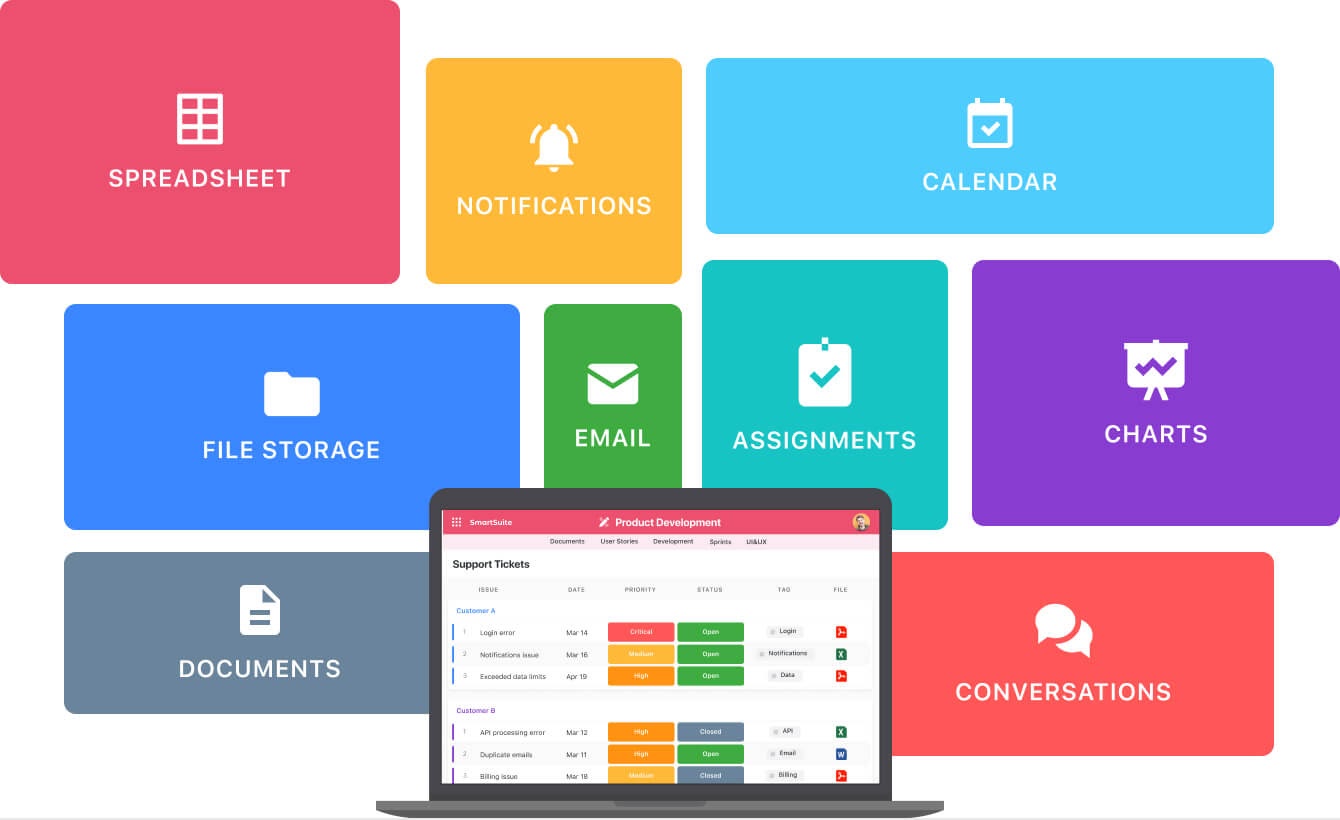
This helps your team stay on the same page at all times.
4. Decision-Making Authority
Cross functional teams must have the authority to make decisions and execute tasks on their own. Why? If your team can use their own initiative and intuition to come up with solutions, they’re better equipped to meet (or even exceed) project goals. Decision-making authority makes your team self-sufficient and helps them do their job as effectively as possible.
5. A Centralized Workspace
In a cross functional team, all members must be able to access information from across the organization. Centralized communication channels offer this possibility. Centralized workspaces give your team access to information across disciplines, even when they're in different locations. By having access to important information from all disciplines, your team can stay on track and within budget while working on the project. For example, with SmartSuite, your team will always have access to their project tasks, which they can check in on while working on other things — and you can even set deadlines for each task.

You can also upload and download files and links to code snippets, presentations, images, or any other supporting documents.

This way, your team can always see what's coming next, and they'll never miss an important deadline.
6. Effective Task Management
People in a cross functional team often have to manage their project work alongside all of their regular daily work. To ensure your team doesn't fall behind, they must constantly track their progress and set achievable deadlines for themselves. An effective task management platform will help your team manage their daily tasks better. For example, with SmartSuite, you can create personal workflows that help your team members track and maximize their project tasks.

You can also set deadlines for each task and get reminders via email of upcoming due dates. Besides, you can monitor each team member's progress to make sure they're staying on track and to help you identify potential delays proactively.

This way, your team will always stay on top of their daily workload and meet important deadlines.
Tips and Ideas to Build and Manage a Cross Functional Team

We’ve already covered the theory. Now let’s step into practice. Here are some helpful ideas to develop and manage a cross functional team in the real world:
1. Define a Clear Project for the Team
A cross functional team is typically set up for tackling a specific project, so the first step is to clearly define the project they’re going to be undertaking.
You should have a clear project plan in place and be able to answer questions like:
- What are we trying to achieve?
- How will we do it?
- By when do we need to finish it?
- Who’s involved? From which functional group or background?
You should also set clear expectations in terms of the results you expect from the team and the level of involvement you require from each member. This way, the team will have a clear direction and avoid wasting time on activities that aren’t specific to the project.
2. Start Small, but Celebrate Progress
Being cross functional doesn’t mean everything will just fall into place overnight. You might feel like each member is from a different planet, all speaking their own language and making it difficult to communicate with them. It takes time for a team with members from different backgrounds to gel and work together smoothly, but this doesn’t mean you should give up before it even gets off the ground.
For this reason, start small. Begin with projects that are unlikely to fail or pose a significant risk to your organization. This will help your team work through any potential obstacles without putting the business at risk. Your chosen project should also have clear milestones so that your team can track progress. This will keep them motivated and help them optimize their efforts accordingly.
3. Have Regular Check-Ins to Keep the Team on Track
Regularly scheduled team meetings are important for keeping everyone on the same page. These meetings should be used to discuss how the project is progressing, what has been achieved so far, and problems that have arisen. This will ensure the team is staying on target to complete projects on time, and it can steer the project in the right direction if required. A solid work management platform can help you manage these meetings with ease.
With SmartSuite, for example, you can easily run team meetings to keep your employees on track. You can turn meetings into tasks and assign the right people to make sure nobody misses any updates.

You can also use the platform to share important documents with multiple people, so everyone has access to the same information. This way, everyone in the project can see what’s going on at any given time.
4. Set Clear Communication Channels
Communication alone isn’t enough. To be effective, you need to make sure you’re communicating the right message at the right time. It’s crucial that cross functional teams communicate with each other in the context of the project they’re working on. Here’s where in-context communication comes in handy.
For example, with SmartSuite, you get access to a variety of features to communicate with your team members, including:
- Comments: Bring conversations directly to where the work is happening.
- Instant messaging: Communicate with teammates and stakeholders in real-time.
- SmartDocs: Brainstorm and develop ideas through the use of collaborative documents.
- File sharing: Share crucial documents with team members.
And many more.
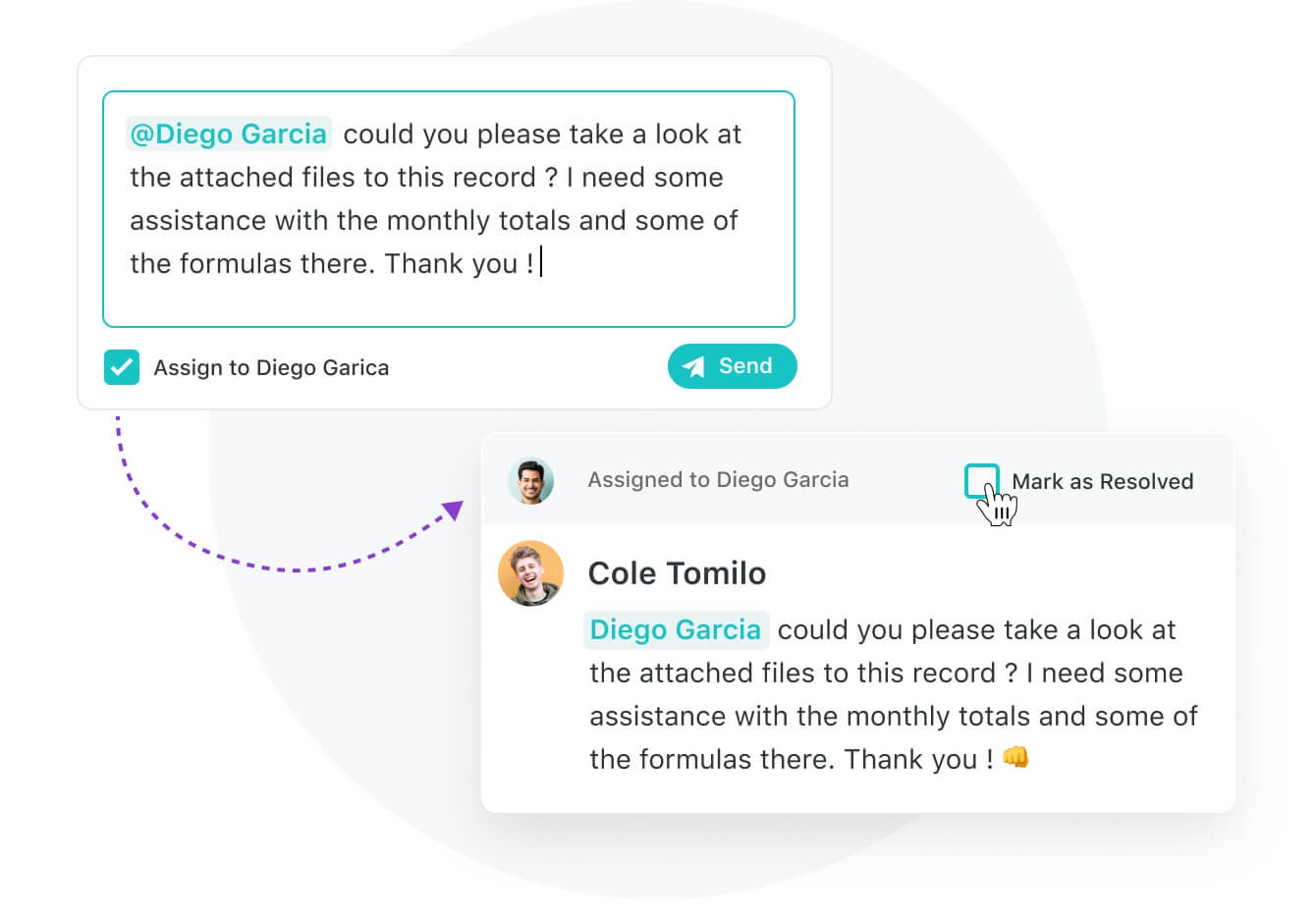
This way, members can add context to every conversation and make sure they’re always on the same page.
5. Use the Right Collaboration Platform
At the end of the day, it all boils down to choosing the right collaboration platform — one that everyone in your team will be comfortable using, regardless of their personal preference or technological know-how.
The right platform can provide a number of advantages right out of the box, such as:
- Team communication
- Knowledge sharing
- Project management
- Task management
- Workflow automation
This means that your team will no longer rely on email or phone calls, which often lead to lengthy conversations and misunderstandings. The right platform also helps you avoid the cumbersome process of scheduling meetings, inviting participants, and updating status reports. So, the question is, what does a solid platform look like in the real world?
In the next section, we’ll cover a few essential features you should focus on:
Essential Features to Manage a Cross Functional Team
At this point, you already understand the importance of choosing the right technology to manage your cross functional team. With so many options available, though, selecting the right platform for your team can be a challenge. That’s why instead of giving you a huge list of different tools, we’ll explore some of the essential features you should look for. This way, your selection process will be a bit easier.
Let’s dive in:
A Central Workplace
Remember — cross functional team members have their day jobs, but they’re also part of the project team. That’s why they need a system to accommodate both roles without having to swivel between systems. You need to make sure all members can access and edit content in the same place. This also helps you keep your digital workplace organized, so it’s easy to find all important documents, even if they’re shared between several people. For example, with SmartSuite, you can create a single place for your team where everyone involved in the project can collaborate.

You can also share information directly with your customers or stakeholders. And you can streamline the entire process for everyone involved. For project teams, you can create regular meetings and discussions and use dashboards to track progress and measure results against daily, weekly, or monthly goals. This way, you’ll always be sure that your people are working on the right things at the right time.
Reporting and Data Visualizations
To make sure everyone knows the status of the project, where they stand, and what their next steps should be, you need to deliver information in a clear and easy-to-comprehend way. That’s why you need a platform that provides you with dashboards and data visualizations. For instance, with SmartSuite, you get access to powerful reporting dashboards that enable you to manage and monitor the progress of multiple projects.
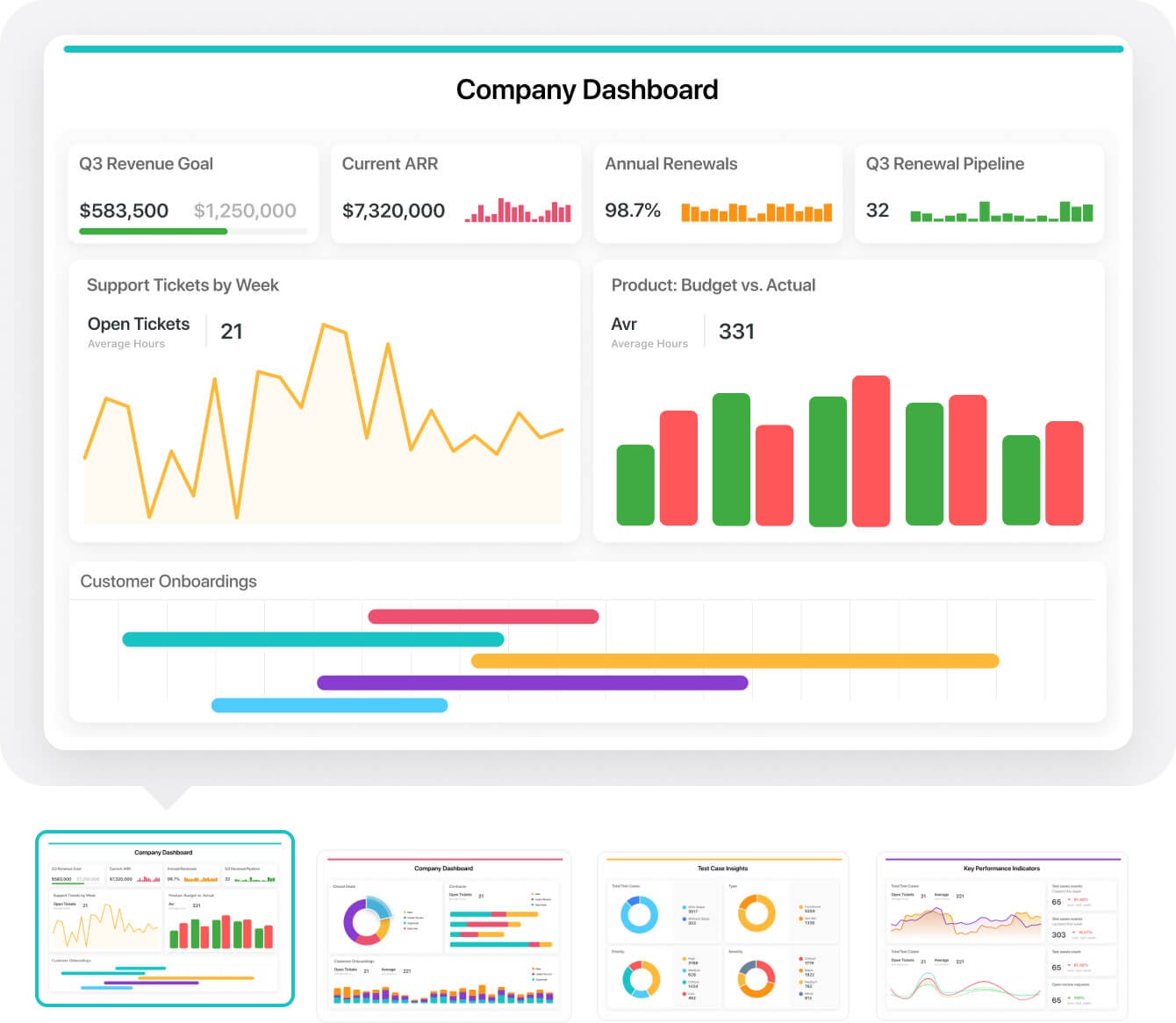
These dashboards are fully customizable and help you visualize the information that's most relevant to you.
Some of the metrics you can monitor include:
- Revenue
- Sales generated
- Tasks completed
- Employee engagement
- Time spent
- Resources used
And many more. You can also filter these elements by specific team members. This will help you get a more accurate view of your team’s performance.
Automations
Cross functional teams can be extremely demanding in terms of time and effort. There are way too many tasks involved. To achieve success, you should automate as many of those tasks as possible. These automations will help your members save precious time and give them the opportunity to focus on activities that really move the needle. With this in mind, you should look for a platform with the right automation functionalities.
For instance, with SmartSuite, you get access to automation rules you can use to streamline any type of task and workflow, including:
- Task creation: Create tasks from scratch automatically, and assign them to specific team members.
- Dependencies: Set dependencies between tasks, and streamline complex workflows.
- Notifications and tagging: Notify and tag team members based on trigger actions.
- Deadlines: Set deadlines for tasks, and make sure your team completes projects on time.
- Repetitive tasks: Automate repetitive tasks and activities, and save otherwise wasted time.
- Custom: Set custom “If this, then that” automation rules to streamline any type of project.
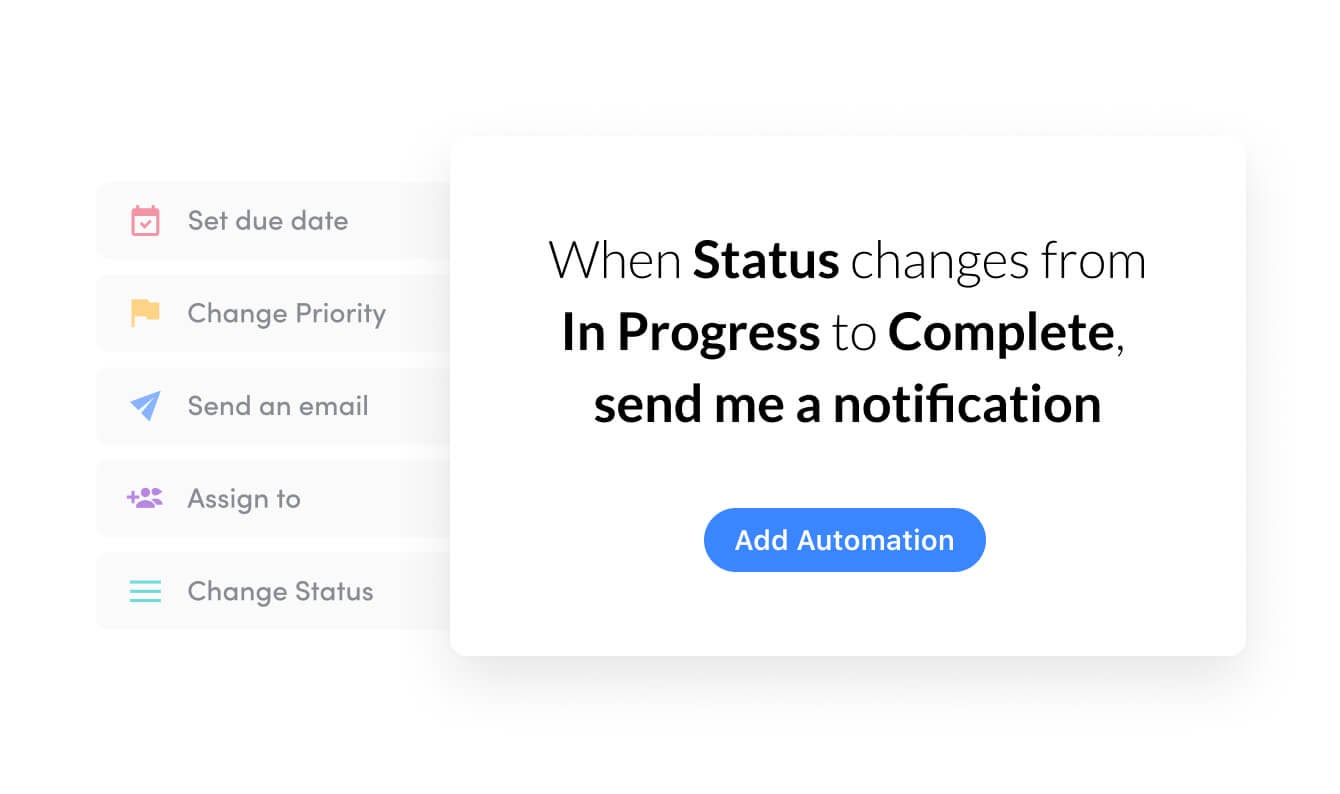
You can configure processes according to your specific requirements, making them as complex as you want.
Project Management Features
Project management is a must-have if you want to control your cross functional team's projects without too many issues. Of course, your chosen software must offer real-time collaboration. As a bonus, it should also provide you with time tracking, budget management, scheduling, and other features that help you stay on top of everything.
SmartSuite, for example, provides you with all the features you need to manage any kind of problem from start to finish, including:
- Templates
- Task management
- Reporting dashboards
- Integrations
- Automation
- In-context communication
And many more. You also get access to multiple data views — like Kanban, Timeline, and Calendar, to name a few — that bring transparency and insight to project management.
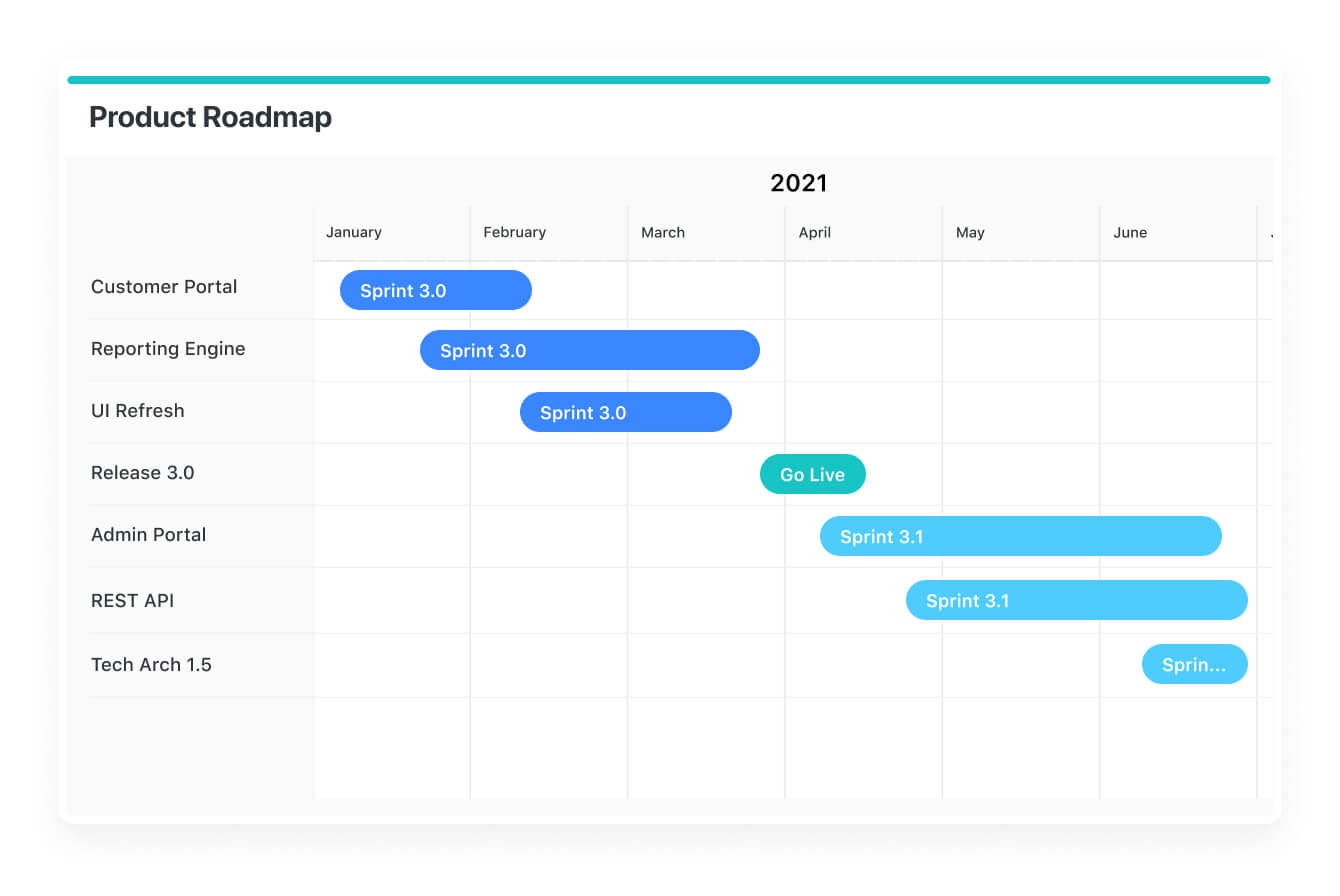
To get a more accurate description of SmartSuite’s work management features, we suggest you visit our product overview page.
Ready to Build and Manage Your Own Cross Functional Team?
Now that you understand the benefits of developing a cross functional team, it’s time to apply that information to your own business. The first step is to centralize your work into a single place. This way, you’re able to remove silos between different departments and communicate much faster. So, if you’re looking for a platform that’s simple to use, flexible, and powerful at the same time, why don’t you take a look at SmartSuite? Our fully customizable project management template will help you start immediately and with way fewer headaches.
Recommended Templates
Frequently Asked Questions
What Is a Cross-Functional Team?
A cross-functional team is a group of people with different functional expertise working toward a common goal. It may include people from finance, marketing, operations, and other departments, collaborating on projects or initiatives that require diverse skill sets.
Why Are Cross-Functional Teams Important?
Cross-functional teams are crucial for breaking down silos within an organization, promoting innovation, enhancing communication across departments, and accelerating project timelines. By bringing together diverse perspectives, these teams can tackle complex problems more effectively.
How Do You Develop a Cross-Functional Team?
Developing a cross-functional team involves defining clear project goals, selecting team members with the necessary skills and expertise from various departments, setting clear expectations, and establishing communication and collaboration tools.
What Are the Key Components of a Successful Cross-Functional Team?
Key components include well-defined goals and KPIs, embracing multiple perspectives, providing the team with the necessary resources and decision-making authority, a centralized workspace, and effective task management.
How Can Software Improve the Management of Cross-Functional Teams?
Software solutions like SmartSuite can centralize collaboration, communication, task management, and documentation. They provide a platform for scheduling meetings, sharing updates, and tracking project progress, making the team's work more efficient and cohesive.
What Challenges Might Arise with Cross-Functional Teams and How Can They Be Addressed?
Challenges include miscommunication, conflicting priorities, and lack of clear leadership. These can be addressed by establishing clear communication channels, setting shared goals, and appointing a strong team leader who can navigate conflicts and ensure the team remains focused on their objectives.
Are Cross-Functional Teams Suitable for Every Project?
While cross-functional teams are highly beneficial for projects requiring diverse skills and perspectives, not every project needs such a team. Simple projects or those requiring specialized knowledge may be better suited to teams from a single department. Assess the project's complexity and requirements before deciding.

Run your entire business on a single platform and stop paying for dozens of apps
- Manage Your Workflows on a Single Platform
- Empower Team Collaboration
- Trusted by 5,000+ Businesses Worldwide















